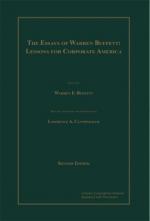
|
| Name: _________________________ | Period: ___________________ |
This test consists of 15 multiple choice questions and 5 short answer questions.
Multiple Choice Questions
1. Most Berkshire _______ had their net worth invested primarily in the company.
(a) Workers.
(b) Shareholders.
(c) Directors.
(d) Secretaries.
2. How many primary holdings were permanent in the time of Buffett and Munger?
(a) One.
(b) Three.
(c) Two.
(d) Four.
3. What was the title of Buffett in relation to his company?
(a) Owner.
(b) Vice-Chairman.
(c) President.
(d) Chairman.
4. In some cases, the benefits of partial ownership earnings may far outweigh the ________ acquisition cost.
(a) Fees and.
(b) Market.
(c) Value.
(d) Per-share.
5. _________ were often unwilling to discuss the business issues during meetings.
(a) The salespeople.
(b) The board members.
(c) Managers.
(d) Shareholders.
6. What was the name of Warren Buffett's partner in the company they shared?
(a) Lloyd Munger.
(b) Charlie Munger.
(c) Steve Jobs.
(d) Bill Gates.
7. Buffett dismissed risk in his choices with his notion that falling __________ prices present an opportunity to buy.
(a) Mortgage.
(b) Checking.
(c) Bond.
(d) Stock.
8. What was coined as the term for the amount of undiscovered embezzlement?
(a) Bezz.
(b) Bezzle.
(c) Bonding.
(d) Embezzling.
9. Munger and Buffett act like ________ when it comes to considering the economic prospects of the businesses they buy.
(a) Business analysts.
(b) Bankers.
(c) Stock traders.
(d) Kids.
10. Buffett managed by ________-related business principles, according to the book.
(a) Stock.
(b) Business.
(c) Owner.
(d) Math.
11. How much was the company worth that Buffett and his partner created at the time of this book?
(a) $5M.
(b) $70B.
(c) $30M.
(d) $10M.
12. _________ can be foolish, according to the lessons in this chapter, foolhardy even, or just be fooling buyers and sellers.
(a) Buffett.
(b) Mr. Big.
(c) Mr. Market.
(d) Smith.
13. Berkshire Hathaway's insurance companies maintained how many permanent common stock holdings?
(a) Three.
(b) Four.
(c) Five.
(d) Ten.
14. What was the name of the bond holdings that Buffett added to Berkshire in 1989?
(a) Pepsi.
(b) RJR Nabisco.
(c) General Mills.
(d) Arrowhead.
15. Who did Buffett authorize to use the essays in the book to popularize the teachings and Buffett's own implementation of the teachings?
(a) Cunningham.
(b) Smith.
(c) No one.
(d) Munger.
Short Answer Questions
1. Alternative investments were considered for __________ high quality investments when a preferable business could not be located.
2. A __________ was something that Buffett and Munger believed was valuable to inform businesses owners of the year's business growth.
3. What is NOT one of the companies listed as having the management requirements that Buffett and Munger want to see?
4. A bond is _______ with regular payment of interest and repayment of principle.
5. The content of the book was often used as a standard text at the Cardozo School of __________.
|
This section contains 400 words (approx. 2 pages at 300 words per page) |

|




